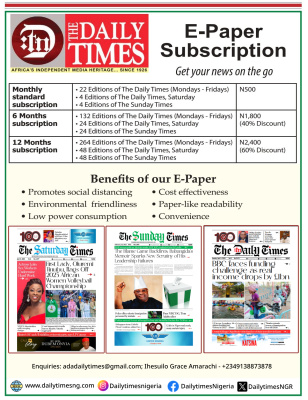How wearing facemask affects the impact of exercise

Wearing of a facemask during exercise will act as a barrier to airflow, which can lower the oxygen levels in the re-circulated air. According to the World Health Organisation, people should not wear masks while exercising as masks may reduce the ability to breathe comfortably.
The world health body said that exercising makes one to sweat, which can make the mask become wet more quickly. This it revealed can make breathing difficult and create room for growth of microorganisms. When exercising, the important preventive measure during COVID-19 outbreak is to maintain physical distance of at least one metre for others.

Dr Raghu Ram, President of The Association of Surgeons of India, says that exercising while wearing a facemask can result in hyperventilation and reduce brain function.
“Wearing a mask during exercise will act as a barrier to airflow, which can lower the oxygen levels in the re-circulated air. In addition, more carbon dioxide exhaled during exercise can potentially be trapped by the mask and when it is re-inhaled, it can further cause excessive breathing or hyperventilation, and reduce brain function. This can manifest as confusion and loss of consciousness as well,” he explains.
It is a well-known fact that heart rate increases during exercise but wearing a mask during exercise further increases heart rate by manifold, which can cause dehydration, light-headedness and dizziness and can even result in adverse cardiac effects.
“It is important to balance the benefits of wearing a mask versus its adverse effects during exercise,” says Dr Ram while adding, “At a time when there is a rapid surge in the number of COVID-19 cases, wearing a mask in public spaces is absolutely essential.
In the absence of adequate evidence-based information regarding use of mask during exercise, it would be prudent not to exercise in public places for a few months,” he suggests.
It basically means that the people might experience a hard time catching their breathe with a face mask on and also might feel worn out and fatigued faster than usual.
“If you have any symptoms like chest pain, dizziness or laboured breathing while exercising wearing a mask, do not exert yourself. Remove your mask and sit for some time, until you catch your breath,” Dr Kanwar recommends.
Another study also disclosed wearing a mask also affects how the exercise affects us. Their research and insights, some of them based on self-experimentation, raise practical questions about whether some types of masks might be better than others for exercise, how often masks should be swapped out during prolonged exertions and just how much we should expect our heart rates to soar if we attempt to interval train with a mask on.
Some official guidelines recommend that citizens cover their faces when in crowded public spaces and shared indoor locations to help block the transmission of the coronavirus disease through respiration.
These recommendations become particularly pressing when we exercise, since past studies show that our breathing rates can double or even quadruple then, sending out higher numbers of potentially infectious respiratory droplets.
However, while there is growing evidence that masks can affect breathing in general, little is yet known scientifically about if and how face coverings change the subjective experience and physical impacts of exercise – although many exercisers will tell you that, they do.
A commentary published this month on the website of the British Journal of Sports Medicine points out that covering your face during exercise “comes with issues of potential breathing restriction and discomfort” and requires “balancing benefits versus possible adverse events”.
Because university closures and other pandemic restrictions prevent large-scale, lab-based experiments now, these scientists’ research efforts primarily have involved wearing masks themselves during workouts or asking a few close colleagues to do the same and taking copious notes. Although anecdotal and unpublished, their analyses provide useful tips and cautions for mask wearing during workouts.
Perhaps most important, they show that masks do alter exercise, says Cedric Bryant, the president and chief science officer of the American Council on Exercise (Ace), a nonprofit organization that funds exercise research and certifies fitness professionals. “In my personal experience,” he says, “heart rates are higher at the same relative intensity when you wear a mask”.
In other words, if you do not wear a mask before running or cycling at your usual pace, your heart rate will be more elevated than before.
“You should anticipate that it will be about eight to 10 beats higher per minute” when you wear a mask than when you do not, Dr Bryant says. This exaggerated rise in heart rate will be most pronounced during intense efforts, he says, such as hill repeats or intervals.
Some people also could experience lightheadedness during familiar workouts while masked, says Len Kravitz, a professor of exercise science at the University of New Mexico.
He is in the early stages of planning a large study of masks and exercise with funding from Ace that will begin when pandemic restrictions allow, he says.
Already he has conducted an informal experiment with two of his students, both experienced athletes. One ran, masked, without breathing difficulties, he says. The other, wearing the same type of cloth mask, felt dizzy after only a few minutes of exertion.
Thankfully, such discomforts likely can be minimized by judicious mask choice and fitting, says Christa Janse van Rensburg, a professor of exercise science at the University of Pretoria in South Africa, who wrote the commentary about masks with her graduate student, Jessica Hamuy Blanco.
Avoid paper, surgical masks altogether during exercise, she says, since they rapidly become wet when we breathe into them vigorously and lose some of their ability to block outgoing germs.
Cotton cloth masks likewise dampen easily. Cloth masks made from breathable, synthetic materials should lessen moisture buildup.
Choose models, though, that “have two layers of fabric or less,” she says, to avoid facial overheating and any bunching of the cloth that might constrict breathing.
Some exercisers may prefer neck gaiters (also called “buffs”), which can be pulled up over the mouth and nose but remain open at the bottom, increasing air flow.
“This can be good from a comfort point of view,” Prof van Rensburg says, “but perhaps with the trade-off of less-effective infection control”. Look for gaiters in summer-weight fabrics, not those designed for use during skiing.
Plan, too, to carry extras of your preferred mask if you will be exercising for more than about 30 minutes, Dr Bryant says. Even breathable fabrics become drenched at that point and should be replaced. Try not to touch the front of the used mask, since any viral particles you came into contact with could have accumulated there, he says, and after removal, pack or dispose of it carefully.
Some athletic clothing companies, including Under Armour, Koral, Zensah and others have begun to manufacture masks for use during exercise. You may need to try several models to find the one that most comfortably fits your face and exercise routine, Dr Bryant says.
But do not be deterred in the interim from wearing a mask if you will be exercising around other people, he continues. Wearing a mask can be particularly important if you are exercising indoors, where air circulation is less likely to dissipate the virus.
COVID-19 infected lawyer urges NCDC to tackle strange illness in Kogi community
“I know some people find them unpleasant” while running or cycling “and there are controversies” about whether they should be mandatory.
“But I look on masks as an opportunity to be a good citizen and show that you care about the well-being of others,” he says, even as you bolster your own well-being with a workout. – New York Times
WHO cautions against use of masks during exercise
Meanwhile, the WHO has warned people against wearing masks while exercising, saying masks may reduce the ability to breathe comfortably.
WHO gave the warning during an update of its Coronavirus disease (COVID-19) advice for the public: Myth busters said that sweat could make the mask become wet more quickly which made it difficult to breathe and would promote the growth of microorganisms.
“The important preventive measure during exercise is to maintain physical distance of at least one metre from others,” it said.
The health agency said that the prolonged use of medical masks when properly worn, did not cause Carbon dioxide (CO2) intoxication nor oxygen deficiency.
It, however, noted that the prolonged use of medical masks could be uncomfortable.
“While wearing a medical mask, make sure it fits properly and that it is tight enough to allow you to breathe normally.
“Do not re-use a disposable mask and always change it as soon as it gets damp.
“Medical masks (also known as surgical masks) are flat or pleated; they are affixed to the head with straps or have ear loops,” it said.
It maintained that the likelihood of COVID-19 being spread on shoes and infecting individuals was very low.
“As a precautionary measure, particularly in homes where infants and small children crawl or play on floors, consider leaving your shoes at the entrance of your home.
“This will help prevent contact with dirt or any waste that could be carried on the soles of shoes,” it said.
According to WHO, the Coronavirus disease (COVID-19) is caused by a virus not by bacteria.
“The virus that causes COVID-19 is in a family of viruses called Coronaviridae. Antibiotics do not work against viruses.
“Some people who become ill with COVID-19 can also develop a bacterial infection as a complication. In this case, antibiotics may be recommended by a health care provider,” it said.
WHO noted that currently there was no licensed medication to cure COVID-19.
It advised people that have symptoms of the disease to call their health care provider or COVID-19 hotline for assistance.
WHO added that most people who contracted the COVID-19 had mild or moderate symptoms and recovered due to supportive care.







